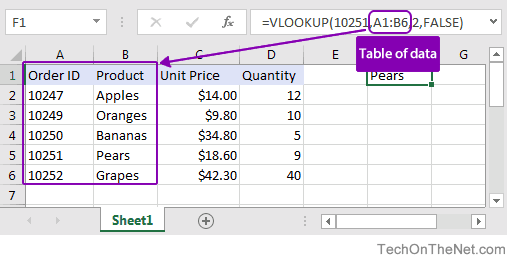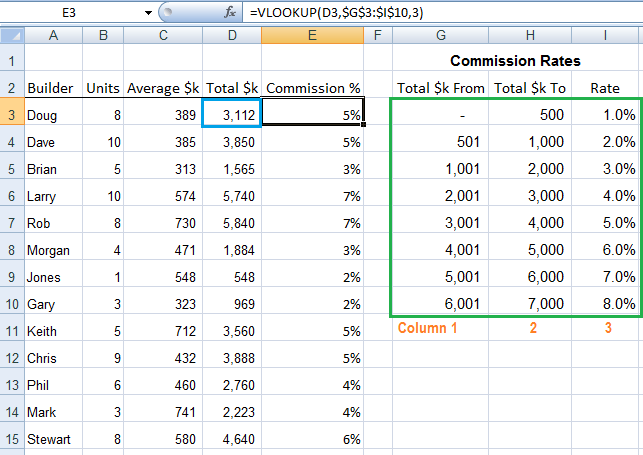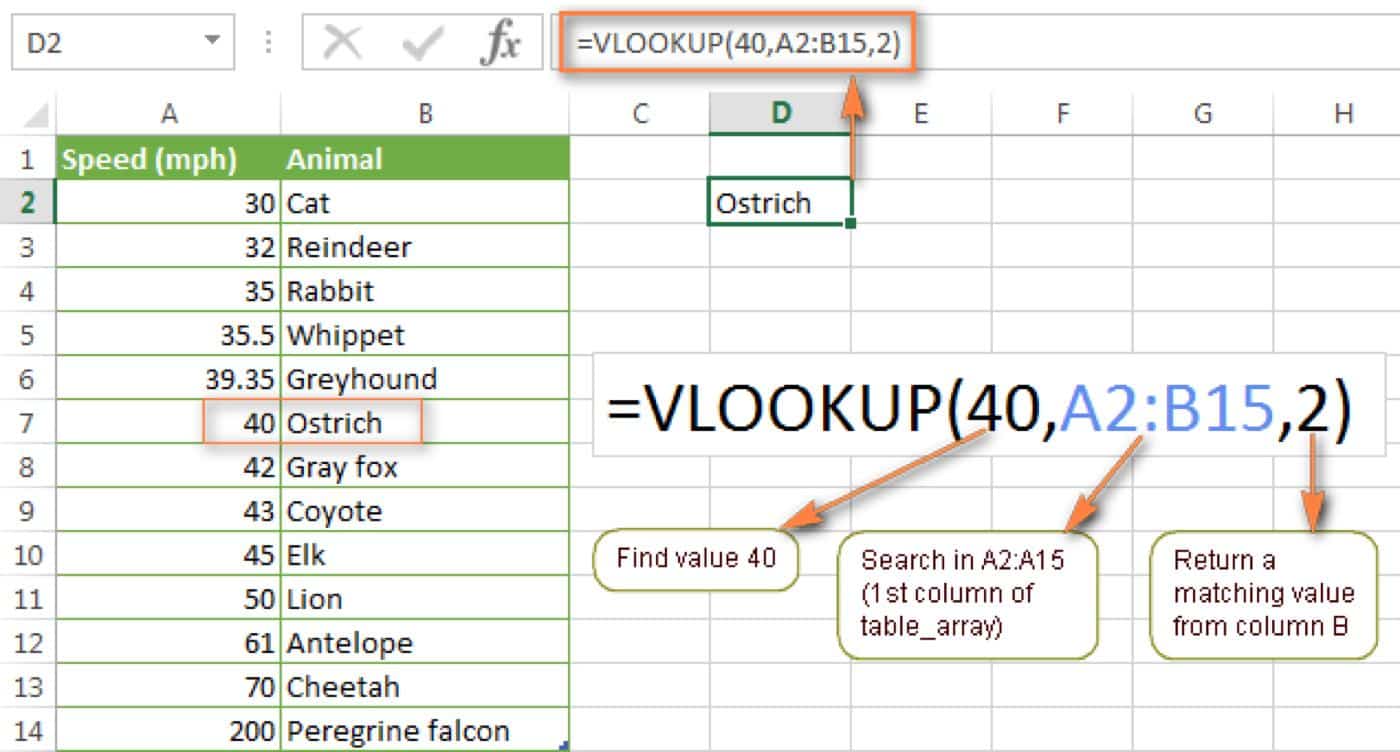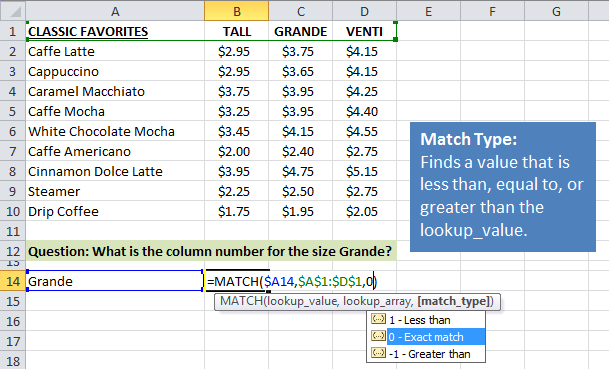The Best Guide To Vlookup For Dummies
Usage VLOOKUP when you require to locate points in a table or an array by row. As an example, look up a rate of an auto part by the part number, or discover a worker name based on their staff member ID. In its most basic kind, the VLOOKUP feature claims: =VLOOKUP(What you wish to search for, where you wish to look for it, the column number in the array having the worth to return, return an Approximate or Specific match-- indicated as 1/TRUE, or 0/FALSE).
Utilize the VLOOKUP feature to seek out a worth in a table. Phrase structure VLOOKUP (lookup_value, table_array, col_index_num, [range_lookup] For example: =VLOOKUP(A 2, A 10: C 20,2, TRUE) =VLOOKUP("Fontana", B 2: E 7,2, FALSE) =VLOOKUP(A 2,'Client Information and facts'! A: F,3, FALSE) Disagreement name Summary lookup_value (needed) The value you wish to look up. The value you intend to seek out have to remain in the first column of the variety of cells you specify in the table_array debate.
Lookup_value can be a value or a recommendation to a cell. table_array (called for) The array of cells in which the VLOOKUP will look for the lookup_value and the return worth. You can utilize a named variety or a table, and also you can use names in the disagreement rather of cell recommendations.
The cell variety likewise requires to include the return worth you desire to find. Find out exactly how to select arrays in a worksheet. col_index_num (called for) The column number (beginning with 1 for the left-most column of table_array) that includes the return value. range_lookup (optional) A rational value that specifies whether you want VLOOKUP to find an approximate or a specific match: Approximate match - 1/TRUE presumes the initial column in the table is sorted either numerically or alphabetically, as well as will certainly then look for the closest worth.
For instance, =VLOOKUP(90, A 1: B 100,2, TRUE). Specific match - 0/FALSE searches for the specific worth in the first column. For example, =VLOOKUP("Smith", A 1: B 100,2, FALSE). There are four items of details that you will need in order to develop the VLOOKUP syntax: The worth you intend to seek out, likewise called the lookup worth.
Fascination About What Is Vlookup In Excel
Keep in mind that the lookup worth must always remain in the very first column in the range for VLOOKUP to work properly. As an example, if your lookup worth remains in cell C 2 then your range ought to start with C. The column number in the variety which contains the return worth. For instance, if you define B 2:D 11 as the variety, you ought to count B as the first column, C as the second, as well as so on.
If you don't specify anything, the default value will always be TRUE or approximate match. Now put every one of the above together as complies with: =VLOOKUP(lookup worth, range containing the lookup worth, the column number in the range containing the return worth, Approximate match (REAL) or Precise suit (FALSE)). Below are a couple of examples of VLOOKUP: Trouble What went wrong Incorrect value returned If range_lookup holds true or neglected, the first column requires to be arranged alphabetically or numerically.

Either sort the very first column, or make use of FALSE for an exact match. #N/ A in cell If range_lookup holds true, then if the value in the lookup_value is smaller than the smallest value in the very first column of the table_array, you'll get the #N/ An error value. If range_lookup is FALSE, the #N/ An error value suggests that the specific number isn't discovered.

#REF! in cell If col_index_num is above the number of columns in table-array, you'll get the #REF! mistake value. For even more info on dealing with #REF! mistakes in VLOOKUP, see How to remedy a #REF! mistake. #VALUE! in cell If the table_array is much less than 1, you'll get the #VALUE! error value.
#NAME? in cell The #NAME? error worth usually suggests that the formula is missing quotes. To look up a person's name, see to it you utilize quotes around the name in the formula. As an example, get in the name as "Fontana" in =VLOOKUP("Fontana", B 2: E 7,2, FALSE). For more info, see How to correct a #NAME! mistake.
What Does Vlookup Not Working Do?
Find out exactly how to use absolute cell references. Do not store number or date worths as message. When browsing number or day values, make sure the information in the initial column of table_array isn't saved as text worths. Or else, VLOOKUP may return a wrong or unexpected value. Arrange the very first column Type the very first column of the table_array prior to using VLOOKUP when range_lookup holds true.


A concern mark matches any kind of solitary personality. An asterisk matches any series of characters. If you intend to find an actual question mark or asterisk, kind a tilde (~) in front of the character. For instance, =VLOOKUP("Fontan?", B 2: E 7,2, FALSE) will certainly look for all circumstances of Fontana with a last letter that could vary.

When browsing text worths in the very first column, see to it the information in the first column does not have leading areas, tracking areas, irregular use of straight (' or") and curly (' or ") quotation marks, or nonprinting personalities. In these instances, VLOOKUP might return an unexpected worth.
You can constantly ask a specialist in the Excel Individual Voice. Quick Referral Card: VLOOKUP refresher Quick Reference Card: VLOOKUP repairing ideas You Tube: VLOOKUP video clips from Excel community experts Everything you need to understand about VLOOKUP Exactly how to fix a #VALUE! mistake in the VLOOKUP feature Exactly how to remedy a #N/ A mistake in the VLOOKUP function Review of solutions in Excel How to avoid broken solutions Discover mistakes in formulas Excel features (alphabetical) Excel functions (by classification) VLOOKUP (totally free sneak peek).
To compute delivery price based upon weight, you can make use of the VLOOKUP feature. In the instance shown, the formula in F 8 is: =VLOOKUP(F 7, B 6: C 10,2,1)* F 7 This formula makes use of the weight to discover the correct "price per kg" after that ... To override outcome from VLOOKUP, you can nest VLOOKUP in the IF feature.
excel vlookup keep leading zeros excel vlookup zero value vlookup in kingsoft spreadsheet